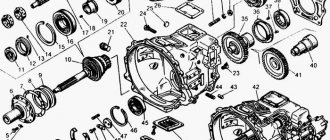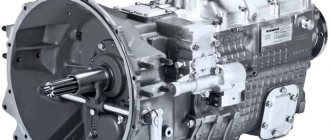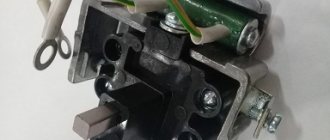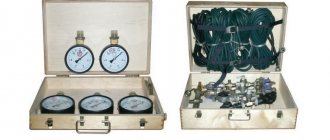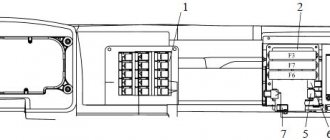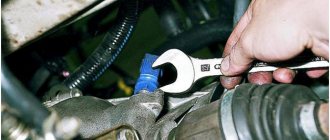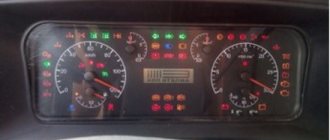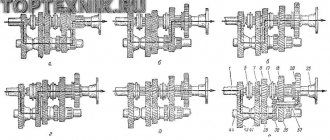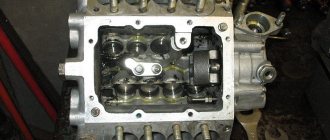How to use a divider on a Kamaz
It is necessary to skillfully combine the divider gears with the gearbox gears.
Acquiring the skills to correctly select gearboxes and dividers can significantly reduce fuel consumption, increase the average speed, create a more economical mode for engine operation, and increase the service life of the clutch, brakes, cardan transmission and drive axles. Gear shifting in the divider is carried out by moving the control valve switch installed in the head of the gear shift lever.
To change gears in the divider, the control valve switch should be moved to the upper or lower position, which corresponds to the highest or lowest gear. Press the clutch pedal all the way and hold it until the gear is fully engaged in the divider (approximately 0.6...0.8 s). When the clutch pedal is pressed all the way, the divider activation valve opens and the divider automatically switches to the selected gear. After this, smoothly release the clutch pedal.
Promotional offers based on your interests:
The control valve switch can be moved to the selected gear position in advance. After this, at the right moment, it is enough to depress the clutch pedal all the way.
When starting the car from a place, the gears in the divider are selected depending on the road conditions and vehicle load.
To accelerate the car to a speed of 10...11 m/s (30...40 km/h) (i.e. to third or fourth gear), it is enough to change the gear in the main box without changing the gear in the divider. To accelerate from third or fourth gear, it is advisable to use both gears of the divider. To do this, when accelerating in difficult road conditions, the following switching sequence is recommended: 1Н—2Н—ЗН—4Н—4В—5Н—5В, when accelerating a car on a paved road—IB—2В—ЗВ—4Н— -5Н-5В.
If during acceleration it is necessary to simultaneously change gears in the main box and the divider, then you should move the switch of the divider control valve to position H, depress the clutch pedal all the way and engage the next higher gear in the gearbox, then smoothly release the clutch pedal.
If the car is moving with the low gear of the divider engaged, and the road resistance has increased and it is necessary to simultaneously change gears in the gearbox and the divider, you should move the divider control valve switch to position B, depress the clutch pedal all the way and engage the next lower gear in the gearbox, then smoothly release the clutch pedal.
Divider KAMAZ 5320 diagram
The diagram of the pneumatic gear shift drive in the divider is shown in Fig. 4.12. Divider switch 1 is located at the upper head of gearshift lever 2. The upper position of switch 1 corresponds to the inclusion of the highest, and the lower position corresponds to the lowest gear in the divider.
In control valve 3 there is a spool connected by a cable in a shell to switch 1. When the low gear is engaged (in Fig. 4.1% position H), this spool is in the upper position. Compressed air from the pressure reducing valve 4 through the control valve $ enters the spool device of the air distributor 6 into its cavity B. As a result, the air distributor spool moves to the left and the cavity D under the piston of the power cylinder 5 is connected to the gear divider valve 7. To engage a gear in the divider, you must press the pedal
11 clutches. In this case, the emphasis on the clutch drive pusher will press on the valve rod 7 of the divider activation, the valve will open, and compressed air from the pressure reducing valve 4 through valve 7 will enter the cavity G under the piston of the power cylinder 5. The piston and the lower end of the gear shift lever connected to it in the divider will move to the right according to the diagram and the lowest gear in the divider will engage.
To engage the highest gear, you need to set the 1st divider switch to the upper position and press the clutch pedal.
Rice. 4.12. Divider gear shift control circuit: 1 - divider switch; B — high gear H — low gear 2 — gear shift lever; 3— control valve; 4- pressure reducing valve; 5— power cylinder; 6—air distribution device; 7— valve for switching on the gear divider; 8 — emphasis; 9— hydropneumatic cylinder; 10— main cylinder; 11 — clutch pedal
To increase the capabilities of standard gearboxes, additional devices are often used in the designs of KAMAZ vehicles - a range multiplier or a KamAZ divider. You can also find information about demultipliers on our website, but now let's talk about the divider...
At its core, this is a mechanical gearbox, the same gearbox, but usually with only two gears - direct and overdrive. Its design contains:
– a pair of cylindrical gears; – a pair of shafts (intermediate and driving); – synchronizer; – switching mechanism.
Gear divider primary shaft
Design and principle of operation
Let's consider the location and design of the KamAZ vehicle gearbox. KamAZ trucks are equipped with manual transmissions. They have 5 speeds. The gearbox is switched by pressing the clutch pedals and moving the gearshift lever to the desired position. Since the car is heavy, it is necessary to transfer the gearbox from one gear to another in several stages.
The principle of operation of the KamAZ gearbox is as follows: with a diesel engine it works either in high mode B or in low mode H. They were created to reduce the load on the engine of a heavy vehicle when it is full, and at the same time not force it to work too actively without load.
The design of a KamAZ gearbox with a divider is simple, but it differs depending on the model of the gearbox. Let's look at the KamAZ gearbox diagram, which is found on diesel vehicles. When driving on a flat road, you need to change gears without a clutch. The design of the KamAZ transfer case can be represented by the following formula: 1B - 2B - 3B - 4H - 4B - 5H - 5B.
Switching speeds is carried out as follows:
- First, switch the gearbox operating mode from high to low using a lever.
- Then release the clutch.
- The lever is set to the desired gear, without jumping over them, but turning everything on in order.
There are gearboxes with automatic mode switching.
Diagram of operation of a gearbox with a divider
Most KamAZ trucks in use today are equipped with five-speed manual transmissions. The gear shift pattern in such gearboxes is quite familiar: the driver depresses the clutch and moves the lever to the required position. It is important to understand that KamAZ vehicles are heavy-duty trucks, that is, adjusting the position of the lever must be done strictly in stages.
gearbox and divider switching diagram
The typical transmission modes for a truck with a diesel engine are low (“H”) and high (“B”) operating modes. The development of these two options was carried out specifically in order to minimize the load on the engine of the machine, both with a maximum load and when empty. Many KamAZ vehicle models allow you to switch these modes without using the gearshift lever.
The driver just needs to raise or lower a special divider switch and literally squeeze the clutch for a second.
The mode is adjusted automatically: a lowered switch activates a light driving mode, and a raised switch activates a stronger driving mode.
Dealing with switching gearbox modes on KamAZ trucks is relatively simple. To change gears 1-5, use the corresponding lever located to the right of the driver's seat. For example, acceleration of a truck involves the use of the following gear shift pattern: 1B-2B-3B-4Н-4B-5Н-5B . On a clogged highway or in difficult road conditions, use 1H-2H-ЗH-4H-4В-5H-5В .
It should be borne in mind that the KamAZ gearbox device allows you to change speeds only if the clutch is disengaged. To switch from the upper mode to the lower one and vice versa, you need to move the switch to the appropriate position and only then press the clutch all the way and as sharply as possible. Literally in a second you need to release the pedal for the desired main gear to engage.
During the operation of the vehicle, it is very important to monitor how much oil is in the KamAZ gearbox, and, as necessary, add lubricant in a timely manner, preventing possible problems and malfunctions.
Specifications
The KamAZ gearbox with a divider includes the following elements:
- a crankcase in which the drive, driven and intermediate shafts assembled with gears are mounted;
- bearings;
- synchronizers,
- reverse gear block,
- top cover of the box,
- gear shift mechanism.
The gearbox of KamAZ vehicles can be five- or ten-speed. The gearbox divider has high and low gears and, in combination with the main gearbox, allows for 10 forward gears and 2 reverse gears. The divider system improves the traction qualities of the machine, makes it easier to control, and reduces the frequency of shifting gears with a lever. Transmission ratios are available in the operating instructions for the device.
The 141 KamAZ gearbox has a reversing light switch. To prevent the simultaneous activation of 2 gears, there is a ball-type lock in the cover, and a spring-finger fuse is used to prevent accidental engagement of reverse gear. The gearbox with divider weighs 320 kg. The cuffs are located in the shaft covers. They protect the gearbox from clogging and prevent oil leakage. Insufficient oil volume in the gearbox leads to its damage. When you first fill the gearbox there should be 9 liters of oil, when changing the fluid - 8 liters.
How to change gears on KamAZ
To change gears correctly, you need to know how the transmission works. The gearbox is designed in such a way that movement is often carried out at a reduced speed, so the machine can transport heavy loads. KamAZ has a 5-speed gearbox. You need to change gears using the clutch pedal and lever.
Start of movement
Before you start moving, you must press the reduced speed. Shift gears only with the clutch pedal depressed. The gear shift pattern is based on staged gear shifting. To start driving a truck, you need to spin the crankshaft of the internal combustion engine.
The second gear must be engaged when the needle on the tachometer reaches mark 3, which means 3000 rpm. This method of gear shifting will make it possible to extend the life of the gearbox and reduce gasoline consumption.
Switching speeds
Let's consider the procedure for switching gears after the car has already started moving. When KamAZ accelerates, the gear shift order is: 4H - 4B - 5H. To engage speed 2, the crankshaft speed must increase to 3000 rpm according to the tachometer readings. The functions of the crankshaft are basic.
Reverse
To engage reverse on a truck, you need to place the switch in the lower left position. Reverse gear cannot be engaged while the vehicle is moving. To engage reverse, you must first completely stop the unit, then perform a maneuver.
Issues of maintenance and repair of the divider gear shift mechanism
The unit in question does not require special maintenance; it is only necessary to periodically check and set the recommended gear shift travel and the gap in the divider switch valve. The procedure for carrying out these operations is prescribed in the operating and repair instructions for the truck. It is important to remember that any adjustments must be made with normal air pressure in the pneumatic system and with the clutch properly adjusted.
If the parts of the mechanism wear out and break, it is advisable to completely replace the complete mechanism (or separately the mechanism and the air distributor). After such a replacement, the above adjustments should be made, and if everything is done correctly, the car will be immediately ready for use.
The gear shift pattern on a KamAZ is not much different from that of a car. But each truck system has its own characteristics.
Switching rules under different conditions
Gear changes depend on the various conditions in which the vehicle is moving. These rules should be followed so that during the use of the gearbox it does not fail.
Climb
During an ascent, you must switch the gearbox to mode H, as a result of which the transmission will begin to operate at increased voltage.
The following rules must be followed:
- When switching from 1st to 2nd gear when ascending a KamAZ truck, you must use the method of depressing the clutch pedal twice.
- In order for the crankshaft to work correctly when changing gears, you need to use the fuel pedal; it also needs to be pressed periodically. At the same time, you can overcome any steepest climb.
- The shaft speed when lifting must be more than 2000 rpm. Otherwise, the engine may shut down, which may cause an accident while driving on the road.
- During the climb, switch to the desired mode, this will facilitate the operation of the engine and all components of the machine.
Descent
Some drivers turn off the engine when descending a mountain to save gas. This should not be allowed at KamAZ.
If you turn off the internal combustion engine during a trip, the electric booster will not perform its functions, which will lead to the steering wheel locking.
KamAZ braking occurs not only as a result of stopping the engine, but also by activating the auxiliary braking system. When a heavy vehicle is going downhill and the driver applies the auxiliary brakes, the clutch should not be depressed and the driver should not shift from one gear to another.
Icy areas
You need to drive a truck on icy areas with maximum speed and range. When braking, you must use the engine stop assist system. If emergency braking is required, the operator must stop the trailer wheels. If you do not take this rule into account, you may end up in a skid.
It is possible to slow down the internal combustion engine only as an exception, as this can lead to its wear. When braking, the wheels should not slip. To avoid this, you need to turn off the reduced speed, which will help reduce the rotation of the crankshaft.
Skid
When skidding, do not disengage the clutch. When the truck skids, you need to turn the steering wheel in the direction of the skid. If the KamAZ skids, you need to take your foot off the gas pedal and press the differential. This must be done using the regulator located on the panel. As a result, the indicator on the panel will turn on. You need to start the move from the second high gear. After overcoming the skid, the differential should be unlocked.
Malfunctions and repairs
Transmission repair consists of disassembling the unit, diagnosing, repairing or replacing worn elements. After the mechanism is restored, the unit is reassembled and the system is tested in operation. You can contact a service center, but it is better to repair the transfer case yourself.
How to check the oil level
The oil level in the box is checked as follows. Unscrew the crankcase plug. When checking, you must install the crankcase indicator into the hole until it stops. The oil from the crankcase of a ten-speed manual transmission is drained through 3 holes. Of these, 2 holes are located in the lower part of the gearbox housing, and the third is located in the divider. The five-speed gearbox housing is drained through 2 holes.
Kamaz gearbox with divider - repair and maintenance
A gearbox (gearbox) is a necessary device for any car. With its help, changes are made in the engine torque and the subsequent transmission of this torque to the working axles. A gearbox with a divider on KAMAZ vehicles facilitates adjustments of both traction and speed characteristics over a fairly wide range, thereby using the vehicle’s power unit with the greatest efficiency.
The device of the box on KAMAZ trucks
The gearbox design used on KAMAZ models does not differ significantly from analogues used by other tractor manufacturers. However, it does have some design features.
The most common gearbox designs installed on KAMAZ vehicles are called model 14 and model 15. They are designed according to the following principle. Several shafts are mounted in the crankcase: intermediate, driven and driving. All of them are equipped with gears and synchronizers. Only the gears of the transmission responsible for the reverse movement are installed in a separate unit. In addition, the upper part of the box is equipped with a separate block in which the speed change mechanism is located.
How to maintain a gearbox on a KAMAZ
In order for the vehicle's gearbox to serve as long as possible, it is necessary to periodically carry out maintenance of this device. These simple measures consist of adjusting the gear shift drive, the gap size in the divider activation valve, as well as periodically updating the oil.
The oil change in a KAMAZ gearbox with a divider must be done at least once per year. This is provided that the car should not travel more than ninety thousand kilometers between two replacements. In models that are used in the construction of large facilities, for transporting cargo in quarries, or operating in other difficult conditions, the oil will have to be changed several times more often. Thus, the duration of the oil operation may vary from that recommended by the manufacturer. This directly depends on the conditions in which the car is operated, as well as on the model of the box installed on the car.
You can check whether the oil level in the box corresponds to the recommended parameters using a special indicator located on the neck plug. This option is used to check models 14 and 15. For gearboxes with index 161 and ZF, you can check the oil level using the control holes, which are located on the gearbox body.
The oil must be changed when the engine is warmed up to operating temperature, since at this moment the oil has a low viscosity. Used oil can be removed through special drain holes located at the bottom of the box. In model 161 you will have to additionally unscrew the oil filter.
Gearbox failures on KAMAZ vehicles
The most common failure of KAMAZ gearboxes is wear of parts. This problem can only be solved by replacing the old structural element.
Sometimes problems arise, for example, automatic transmission switching off or difficulties when turning it on, the reason for which lies in the violation of the adjustments of the mechanisms and components of the box. In this case, you just need to return the technical value of the adjustments to their original position and the problem will be solved.
Why and how often you need to flush your car's cooling system, as well as which cleaners are best to use, see here. What kind of oil should be poured into the engine and what you need to pay attention to when choosing, read here.
The device of the gearbox divider for KAMAZ vehicles
To carry out repairs, you need to know well how the structure works or have a diagram of a KAMAZ gearbox with a divider at hand. The gear divider itself is a mechanical gearbox, the main task of which is to increase the gear ratios of the main gearbox. The divider design consists of the following components:
- two gears;
- blocking synchronizer rings on both sides;
- synchronizer clutch with teeth;
- two types of shafts;
- device body;
- a fork designed to change gears, as well as a lever for these purposes and a fork shaft.
Repair of gearbox divider for KAMAZ vehicles
The list of repair work for the gearbox divider consists of disassembling the structure of the device, then there is the process of troubleshooting and replacement of worn elements, then the process of assembly and testing.
Disassembly of the divider structure is carried out according to the following algorithm:
- First, the gear shift fork is dismantled; to do this, you need to remove the air switch, unscrew and unlock the fastening bolts and remove the roller;
- the synchronizer is dismantled;
- a one-time removal of the shaft and fork located on the release lever is performed;
- the fasteners that hold the rear bearing cover on the input shaft are unscrewed. Next, this cover must be removed;
- together with the bearing, the shaft itself must be dismantled; in this case, the teeth of the second shaft must be aligned with the cutout located on the drive gear;
- thanks to the presence of threaded holes, which are specially made on the intermediate shaft for easy removal, the bearing cover is dismantled;
- Next, you need to unscrew and unlock several fasteners to remove the support bearing washer, and also dismantle the roller bearing on the driven shaft. To directly remove the bearing, you will have to remove the cup where it is located. To do this, simply unscrew the fastening bolts;
- The bearing is removed together with the glass;
- then you need to knock out the shaft and remove the bearing from the divider housing. For these purposes it is better to use a wooden beam. Under no circumstances should the shaft be knocked out with a hammer. This may damage the parts;
- All that remains is to disassemble the input shaft. To solve this problem, you will need a vice, since the design provides a coupling nut with a thread on the left side. The splined part of the shaft is clamped in a vice, after which you can remove the oil pressure washer, as well as the roller bearing and bushing and the drive gear.
Once defects in structural parts have been identified, it is necessary to either eliminate them or replace worn parts with new ones. In order not to resort to monthly repairs of the box in the future, it is best to use only original spare parts from the manufacturer. Fortunately, purchasing parts for a gearbox divider for a domestic car brand is not such a big problem. And the build quality of “native” spare parts is always higher than that of their Chinese counterparts.
The divider is assembled in the reverse order.
Gearbox control
Shift gears in the gearbox using the gear lever located to the right of the driver's seat. Change gears with the clutch disengaged. Press the clutch pedal all the way. Engage and shift gears at minimum idle speed. Start driving only from first gear (to avoid premature clutch failure). To quickly accelerate the vehicle on good roads and in difficult conditions, it is recommended to use all gears sequentially according to gear shift patterns. In cars with a cable drive to control the gear shift mechanism, a gearbox with a servo shift is used. The servoshift serves to facilitate gear shifting; air is supplied to it from the car's pneumatic system.
Attention! Do not change gears until the operating pressure in the pneumatic drive is reached (from 6.5 to 8.0 kgf/cm 2 ) to avoid cable breakage due to the servo shift not developing the required force.
If there is a divider in the gearbox, a gear divider control switch is mounted in the gear shift lever handle (see Fig. Gear shift lever). The switch can be used to select the highest “B” or lowest “H” gear in the divider. It is recommended to use the entire range of low and high gears. To switch from a higher gear to a lower one, and vice versa (without shifting the lever), you need to move the gear divider control switch to the desired position, and then press and release the clutch pedal after a short (1 second) delay - the gear will engage automatically. To simultaneously shift the lever and engage a higher or lower gear, set the divider control switch to the “B” or “H” position, press the clutch pedal and shift the lever.
Gear shift lever
For gearboxes of models 144, 154, shift gears according to the diagrams (see Fig. Gear shift diagram in a model 144 gearbox and Gear shift diagram in a model 154 gearbox).
Shift diagram for a 144 transmission
Shift diagram for a 154 transmission
For the ZF 9S1310 model gearbox, shift gears according to the diagram (see Fig. Gear shift diagram in the ZF 9S1310 model gearbox):
- 1-2-3-4-lower gears (lowest range of multiplier);
- 5-6-7-8-high gears (highest range of range).
When slowing down, change gears only sequentially: 8-7-6-5-4-3-2-1. Always keep the gear engaged when driving.
Gear shift diagram in the gearbox model ZF 9S1310
Low gear “C” is intended for starting in difficult road conditions and for maneuvering.
Attention! For gearboxes it is strictly prohibited:
- switch from the highest range of the multiplier to the lower range of the multiplier at a speed of more than 30 km/h (for ZF gearboxes);
- move with the gear shift lever in neutral position;
- engage reverse gear (R) when the vehicle is not completely stopped and when the clutch plate is rotating.
Gear shifting in the multiplier occurs automatically: the highest gear is engaged when the gearbox control lever moves from the fourth to the fifth position, the lowest gear is engaged when switching from fifth to fourth. When the lever is moved through the “◊” position, the valve is activated, providing automatic switching of the range multiplier. When the low range is turned on in the range multiplier, the warning lamp lights up on the instrument panel
. When the range shifter is switched, the gear shift lever rod of the main box is blocked, and a force is felt on the lever, after which it is recommended to wait 1-1.5 seconds to ensure the gear shift in the range shifter.
Kamaz gearbox: device, divider, switching diagram
For a car, the gear shift mechanism is a device, without which operation is unthinkable. If in passenger vehicles the transmission is not considered a simple unit, then in heavy equipment due to its size and weight, things are much worse. Therefore, the KamAZ gearbox is a structurally complex device that requires skills and abilities when handling and maintaining.
Most foreign manufacturers install automatic transmissions on heavy equipment. The creators of KamAZ, in order to simplify the design and increase the reliability of the product, followed the path of a mechanical device. The KamAZ gearbox diagram increases the effect of using the vehicle. Simplicity and convenience make the unit cost-effective.
KamAZ control - Shifting gears on a dump truck
At first glance, driving a KamAZ is similar to driving a car. The principle of operation is the same as on classic transport, however, some features cause complications for the uninitiated user.
You get a complete understanding of how to properly drive and drive a KamAZ by understanding the specifics of gear shifting. The fact is that for every heavy car you need to find an approach to the issue of manipulating the gearbox, and KamAZ is no exception. In order to achieve the required speed limit when transporting cargo, the KamAZ transmission is often operated in a low gear. The acquired skills, knowledge and experience in working with the gearbox are the key to the success of further operation of the vehicle.
Description of the boxes used
The gear shift pattern directly depends on the type of transmission installed on the KamAZ vehicle. Most of the machines used use a box with five forward speeds and one reverse; this is a model with index 14. The mechanism is relevant if there is no need to tow a trailer, or the cargo being transported weighs less than 10 tons.
Box modifications
The type of box installed depends on the loads the vehicle experiences and the conditions in which it is operated:
The fourteenth transmission is a five-speed device, which includes a gearbox. The fifteenth modification of the product with ten stages, unlike KamAZ-14, is equipped with a divider with two stages, the device is located in the front part of the box.
Gearbox KamAZ-14:
Transmissions are controlled mechanically, remotely, using a swing lever located on the power plant. The mechanical gearbox is controlled by pneumatics and mechanics, through a selector. The driver directly acts on the rocker.
The sixteenth gearbox, with eight shift stages, is of mechanical type. The design includes a four-stage gearbox and a reduction box mounted behind the structure.
The base of the rod that switches the stages is installed on the gearbox plug; the lever itself is made in an original design solution. The product contains a rod that controls the gearbox, a lever, a safety net that prevents erroneous start of reverse, and valves controlled by pneumatics and switching a mechanism that increases torque.
Gearbox KamAZ - 15:
The ZF gearbox on KamAZ with nine stages is equipped with an auxiliary reduction gear, unlike the 16 model.
The KamAZ 5320 gearbox is equipped with five stages. Since the equipment is operated in harsh conditions, it is equipped with large gear ratios for operation at low speeds. Switching occurs in stages, the transmission easily adapts to road conditions.
KamAZ ZF gearbox:
Gear controls on modern cars are different. A mechanism with fewer gears is used on vehicles with a smaller load capacity and dimensions. Modifications of 10 stages are installed on road trains. KamAZ is in demand in 40 countries because the control mechanisms are reliable and durable.
Modifications of KAMAZ gearbox
How to correctly determine the KAMAZ gearbox model. One car model can be equipped with a different transmission option.
To date, the Kama Automobile Plant has produced several dozen types of chassis. As a rule, most of them were modified and improved during their release. Transmission components are no exception. This led to the fact that completely different gearboxes could be found on identical KAMAZ chassis.
Many motorists, not knowing this, do not think about it when searching for the necessary unit. This typically results in people purchasing the wrong transmission components.
Below, as an example, we provide a list of various modifications of the chassis and gearboxes that were installed on them.
KAMAZ 4310, 43101.
The first all-wheel drive all-terrain vehicles were equipped with a 14 box without a divider. Later, the transmission was strengthened (shaft and synchronizers) and was replaced by gearbox 142.
KAMAZ 5320, 55102, 5511, 5410. All these vehicles are built on the same 5320 chassis: flatbed truck, dump truck, tractor and collective farmer. At the beginning of mass production, they were equipped with a 15 box with a divider; later, changes occurred and were replaced with a new analogue - Gearbox 152.
KAMAZ 55111, 53229, 43253. The dump and shortened chassis was equipped with gearbox models 142 and 152. After 2010, imported ZF transmissions - 6S 700 and 6S 1000 - began to be installed on single-axle models 43253 and 43255.
KAMAZ 4308. ZF - 6S700 TO and 6S1000 TO, first releases - Gearbox 141.
KAMAZ 53215. Flatbed truck 53215 has been produced since 2001. During this time, the chassis was equipped with two modifications of transmissions: - 142. An upgraded version of the 14th model. It has five forward and two reverse speeds. Article - 142.1700025; — 152. Modernized version of model 15. It has 10 speeds for moving forward and two in reverse. Equipped with a divider. Article - 152.1700156. The operating principle of the units is extremely similar. In the second case, the KAMAZ 53215 gearbox is additionally equipped with a gear divider. This device allows the car to climb hills without loss of power.
Do you need a KAMAZ gearbox?
KAMAZ 44108. The all-wheel drive all-terrain vehicle of the Kama Automobile Plant could be equipped with gearboxes from both domestic and foreign manufacturers: - ZF9 - has nine speeds for moving forward, one for moving backward (R) and a “creeping” speed (C); — 154. The main difference is the use of tapered bearings. Just like its predecessor, this unit has ten speeds for moving forward and two for moving backward. Despite the fact that the units are radically different, they are interchangeable.
KAMAZ 53212. As a rule, a standard 142 gearbox or a ten-speed 152 gearbox with a divider was installed on the onboard tractor.
KAMAZ 65115. Depending on the modification, the dump truck can be equipped with a reinforced ten-speed 154 or a foreign nine-speed ZF9.
KAMAZ 5311. The dump truck is one of the first produced by the plant. It is equipped with a gearbox 14-100 (5 speeds) and 15-250 (10 speeds). It is worth noting that the nodes are completely interchangeable with their modified versions (142 and 152, respectively).
KAMAZ 43114, 43118. All-terrain vehicles of this model were equipped with several types of gearboxes: - 142; - 152; - ZF9; — ZF16 – Sixteen-speed equipped with a divider and multiplier. Article - 1341.002.073. In addition to the four listed above, the enlarged version of KAMAZ 43118 was also equipped with gearbox 154.
KAMAZ 6520. The modern 6520 (Mammoth) dump truck was equipped with a sixteen-speed ZF16 151/1820. The gearbox on the KAMAZ “Mamont”, like other ZF models, is economical and reliable.
Gearbox for dump trucks 6522, 65222 and 65225 - ZF 16S1820 or 16S1821 TO. Similar units were installed on model 65111.
KAMAZ 5460, 6460. ZF16S151 (16s1820 to) was installed on truck tractors, as well as on other EURO-2.3 vehicles. The gearbox of this model is considered high-speed. In the latest releases, automatic transmissions ZF 12AS began to be installed.
KAMAZ 65116, 65117 has a modern nine-speed ZF 9S1310 TO.
Summing up
Before purchasing a transmission, carefully check the number indicated directly on the unit. If you find it difficult to choose a transmission, call the number indicated on the website. A qualified specialist will contact you. Through us you can search the factory database by indicating your chassis number (XTC).
Description of gearboxes
Structurally, the ten-speed transmission is a box with five steps and a gearbox. This design uses 10 forward gears and 2 reverse gears. The transmission is popular and is used for installation on vehicles carrying heavy loads. The mechanism received index 15.
Distinctive features of the KamAZ-15 box:
- Used in conjunction with a reinforced divider synchronizer;
- The splines have been modernized and strengthened, the fastening parts have been removed from the box;
- The fixation of transmission gears has been modernized;
- The height of the teeth has been increased.
Downshift (divider) valve for KamAZ-15:
The pneumatic system activates and controls the KamAZ transmission dividing device. The performance and durability of the unit directly depends on the correct use of this unit. For the same reason, inspection of the KamAZ transmission is carried out at specialized stations.
KamAZ transmission elements:
- Box body with built-in shafts: driving, driven, intermediate;
- Gear mechanism for activating reverse;
- Upper casing;
- Collapsible mechanism that switches stages;
- The power unit is located in the front of the body.
Features of the design and operation of KAMAZ gearboxes
KAMAZ trucks are currently equipped with a fairly large number of gearbox models, which, with minimal design differences, have different characteristics:
- Gearbox 14 model range - models 141, 142 and 144;
- Model range of gearbox 15 - models 152 and 154;
- Model range of gearbox 16 - represented by one model 161;
- Gearboxes manufactured by ZF-KAMA - a wide variety of manual transmission models 6S, 9S and 16S, automated gearboxes 12A and automatic gearboxes 6H.
Gearbox 14 is the simplest 5-speed three-way gearbox with manual control and synchronizers. They are installed mainly on dump trucks and other single vehicles operated without trailers.
Gearbox 15 is a modernized Gearbox 14, to which a divider has been added. Thanks to the use of a divider, the number of gears is doubled (up to 10 forward and two reverse). The divider is a single-stage gearbox, built on one pair of conventional cylindrical (usually helical) gears, installed between the clutch and the gearbox (in fact, it is located in the clutch bell, which is integral with the gearbox housing). The divider has pneumomechanical control; if necessary, direct or reduction gear is engaged, due to which the total number of gearbox speeds is doubled.
Gearbox 16 (model 161) is an 8-speed gearbox with manual control, which uses a planetary range shifter instead of a divider. In fact, this is a 4-speed ZF gearbox, in which the total number of gears is doubled due to the planetary gearbox. This box is produced by the ZF-KAMA joint venture.
Box divider
High and low operating modes, a feature of KamAZ gearboxes. This specificity is caused by the desire to reduce the load on the power plant. It is typical that it does not matter whether the machine is loaded or not. A divider is a gearbox based on the principle of mechanics and increases gear ratios. The mechanism is started using a switch on the rocker.
KamAZ-15 box divider input shaft:
- The valve that controls the device. The part is attached to the base of the switch, uses direct and reduced speed modes.
- A valve that maintains a constant outlet pressure. It takes compressed air and resets the pressure in the system when the established values are exceeded. Transfers air to the control valve and to the valve of the dividing device from the air unit. Thanks to manipulations, there are simultaneously two circuits in the engine control system.
- Divider activation valve. Supplies air pressure to the device when the clutch is disconnected. This engages and disengages low gear, paralleling the transmission's gear changes.
- Dividing mechanism. The composition includes a piston placed inside a cylinder. The piston lever is connected to a rod fixed to the fork shaft of the assembly. When air pressure hits, the piston moves, this changes the operating mode of the box.
- The air distribution pipe supplies air pressure to the cylinder of the unit.
Design and operation of MPPD
The mechanism consists of a cast case, in which three main parts can be distinguished:
- Box for the fork shaft lever - this box contains the lever and the part of the piston rod connected to it;
- A sealed cylinder in which the piston is located;
- A small diameter cylinder connecting the large cylinder to the box - this is where the piston rod is located.
In the lower part, a control unit - an air distributor - is attached to the MPPD housing. It is a tube in which a spool is installed, providing compressed air above or below the piston. On both sides of the spool there are pistons located in sealed cylinders - with their help, the spool is moved when the divider switch on the lever is moved to one position or another. The spool and pistons are part of different circuits of the divider control pneumatic system, so they are sealed to each other.
The mechanism works as follows. When the switch on the lever is moved to the lower position (reduction gear of the divider), the compressed air from the control valve is divided into two circuits and supplied:
- Into the right control cylinder of the air distributor;
- At the input of the divider switching valve.
Under the influence of the force of compressed air, the distributor spool moves to the left, opening access of compressed air to the left cavity of the MPPD cylinder. However, at this moment the divider switch valve is closed, so no switching occurs. When the clutch pedal is depressed, this valve opens, and air under pressure is supplied through the spool into the cylinder - under its action, the piston moves to the right, and its rod pulls the lever, as a result of which a downshift or upshift of the divider is engaged. If the divider switch on the lever is moved up, all processes occur in the reverse order.
